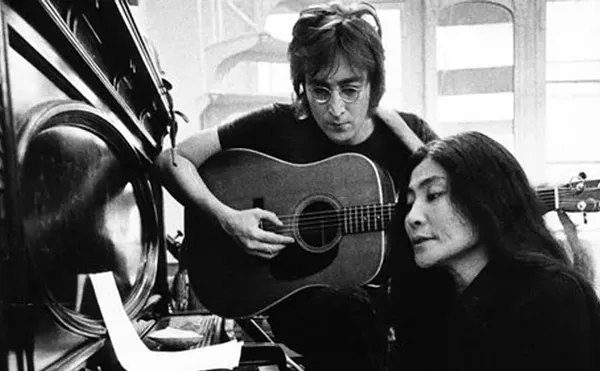
Audio By Carbonatix
[
{
"name": "GPT - Leaderboard - Inline - Content",
"component": "35519556",
"insertPoint": "5th",
"startingPoint": "3",
"requiredCountToDisplay": "3",
"maxInsertions": 100,
"adList": [
{
"adPreset": "LeaderboardInline"
}
]
}
]
The morning mist had taken all day to lift, but you could count the Pleiades the night the two strangers disappeared. Friends-of-a-friend, they came from the north to a barbecue in Arcata, Calif. They shook hands all around, made a little small talk, and set out on foot to the corner store for beer and potatoes for baking. Then they vanished.
The state trooper was incredulous. "Have you checked the jails?" he asked.
"You don’t understand," said the anxious barbecue host. "They’re Canadians."
"Have you checked the jails?" the trooper repeated. By the time the missing persons report had been filed, the two of us were somewhere east of Reno.
The Nevada high desert is a landscape of speed. Warplanes howl overhead. Futuristic vehicles hurtle across the playa, chasing the 1997 Mach 1 land speed record of Andy Green. Even the jackrabbits are abnormally, absurdly, suicidally fast.
And in a rented, value-model Honda Civic Sedan, we were traveling at 140 mph, quicksilver moving up an asphalt thermometer. We were road tripping.
"The car is America and America is the car. The car is the myth and metaphor for America." So wrote Lydia Simmons, along with pretty much everyone else. It is a national mantra, repeated and accelerated since the 1920s, when we retired the old motto: "The choo-choo train is America and America is the choo-choo train."
In the ‘20s, we put the boots to the railway caboose. No more Mr. Timeclock! No more Mrs. Schedule! The railway octopus, with its lockstep timing and sharp divisions of status, stank of Old World values. Trains were orthodox and undemocratic, muddling through doppelgänger towns and along valley bottoms while their passengers dreamed of mountain vistas.
Back then, drivers were "motor hobos." Driving was an anti-modern protest — "Thoreau at 29 cents a gallon."
At an average of 20 mph, it wasn’t about speed. In the bloodiest decade in U.S. driving history, it wasn’t about ease of mind, either. Instead, the automotive revolution was a return to "natural rhythms," a primal resistance to technological efficiency and creature comforts.
"The future conquered the present by coming disguised as the past," explains Warren James Belasco in Americans on the Road.
For six days, a friend and I sought the legacy of these conquerors. A road trip is a unique adventure, one in which giddiness replaces pleasure, and misery is inflicted under conditions of climate-controlled comfort.
Yet road trips are celebrated above all forms of recreation, save sex. Friends ground their teeth with envy. For us, the freedom of the road. For them, another workaday week, moments of gridlock between online investments.
Ten hours later, I was staring into the dark of the Pacific redwood forests. Yellow-line fever had set its grip; the sea mist and bright stars, things I understood to be beautiful, were instead causing headaches and forcing me to squint. I longed for an exit and its predictable promises: Taco Time, Motel 6, BP Gas.
My road trip notes say a lot about decadence and adventure. There was our spontaneous Flight From Arcata, the Night of the Drunken Trapeze Artist, the Lap Dance Conundrum, the Dope Dealer Debacle, even the Genital Piercing Incident. The unfettered spirit of these moments is what sells SUVs that never get muddy and sedans that poop out in the Errandsville rut. But the notes also reveal that memory is a shill to the image-makers.
Without evidence in ink, I would already have forgotten the long stretches of intense boredom ("TV mode," said one driver-fatigue specialist). The bland gaudiness of Reno and the gaudy blandness of Spokane. The hucksterism of The Trees of Mystery and the ecological crisis rising in yellow gusts from I-90. The sense that every gesture of freedom has been sold to me by the makers of Thelma & Louise and whoever it was that turned Hunter S. Thompson into a frathouse caricature.
These sensations poured over me on Route 50, "the Loneliest Road in America." This is road trip country, all big sky and distant rain over purple mountains. Prisons outnumber towns, and you race to outrun the loneliness until night falls and the Nevada desert fills with the Key lime eyes of animals. Give it back, I thought as darkness fell.
We choose our road trip landscapes for their sense of limitless possibility, and then we carve them into strips. Give it back. Roll up this road to nowhere and give the Big Empty back to the creatures of the night.
Two hours later we were back on the interstates, those "freeways" that began as "national defense highways" inspired by the Nazi autobahns. Despite the late hour, traffic was bumper to bumper.
There is a sense of umbilical connections — the sameness of highways in New Jersey or Texas, a 110-mph nation all tuned in to talk radio.
We are howling at top speed across the gap between vision and reality, craving more horsepower to reach an ever-receding horizon. We have miles to go before we sleep. Somewhere, a train whistle mourns into the night.
On the fifth day of our trip, my friend and I escaped the road’s perpetual culture of escape. At the edge of the Teton Range, we stopped to walk a small ridge above Jenny Lake. There, I made a game of climbing a 12-foot boulder, finding as many different routes as possible to its lowly summit.
It was epic struggle writ small, and each time I crawled over the final lip my shirt was painted by the sunset. Only from the top could I see the toothy shadows of the Tetons piercing a hundred miles across the Wyoming plains.
From there, we drove 14 straight hours to home.





